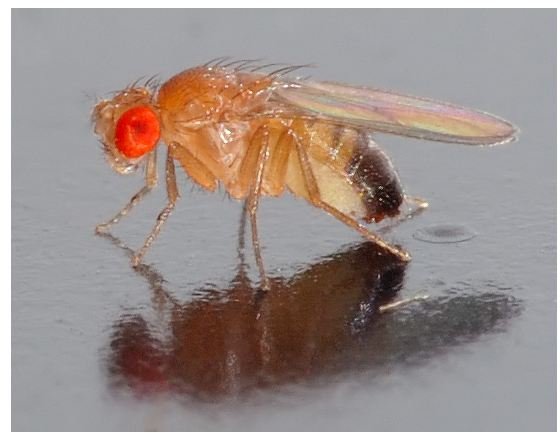Drosophila Melanogaster and Human Genetics. How Studies of the Fruit Fly Advance Science
Drosophila Melanogaster/Human Similarities
To the naked eye Drosophila melanogaster looks like any other fly. There are wings, a head, a thorax, and an abdomen. But beneath these external structures is a genome that has provided scientists with a wealth of knowledge about genetics, diseases, and patterns of inheritance. Despite the obvious morphological differences fruit fly and humans share many molecular, cellular, and behavioural similarities. In fact in an interview with BBC News Online, the Drosophila Genome Project’s Professor Gerry Rubin, from the University of California, Berkeley, said this about our friend the fruit fly. “They can become addicted to alcohol, cocaine and other drugs. They have a wake-sleep cycle like humans do. They have complicated rituals of behaviour.”
Favourite Fruit Fly
_
Drosophila melanogaster was really shoved into the scientific limelight by one of the most famous scientists in genetics, Thomas H Morgan. In the early part of the 20th century his use of fruit flies led to the discoveries of chromosomes, sex-linkage, and the genetics of sex determination. Morgan’s laboratory at the University of Columbia became known as The Fly Room.
Some of the reasons why Morgan picked the fruit fly as his experimental subject are included in the following list of why they are still so popular today:
- Easy to culture.
- Short life cycle.
- High fecundity (females can lay up to 100 eggs a day).
- Males and females are easily distinguished.
- Easy to obtain virgin males and females.
- They use similar genes to humans to develop into adults.
- They use similar biochemical pathways to humans.
Drosophila Genome
The fruit fly Drosophila melanogaster has four pairs of chromosomes - the sex chromosome pair, and three autosomes, labelled, two, three, and four. In the year 2000 the entire drosophila genome was sequenced. There are 165 million bases pairs containing more than 13, 000 protein-coding genes (humans have 20,000-25,000 genes).
Contribution of the Drosophila Genome
Drosophila melanogaster’s past and current contribution to human genetics and science in general are far too many to be listed here, but include the following - understanding of the early development of the embryo, and also of organ and tissue formation, and the discovery of sex-linkage. They are also used as models for several genetic disorders including Alzheimer’s, Parkinson’s and Huntington’s. In addition geneticists use the fruit fly to look for homologues of human disease genes, to see how they function/malfunction, and if they cause similar disorders.
With new knowledge coming from the Drosophila Genome Project, plus the fact that they are so easy to manipulate means that the firm friendship between fruit fly and geneticist is set to continue for many years to come.
